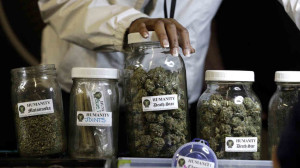Medical marijuana is big business in California. In 2015, dispensaries here sold more than $1 billion worth of cannabis, accounting for almost a fifth of the $5.4 billion sold nationwide.
 That’s not much of a surprise. Medical marijuana has been legal in California longer than anywhere else; it started in 1996 when voters passed the Compassionate Use Act at the ballot box. What may be more unexpected, though, is the decline in those numbers that is likely over the next few years.
That’s not much of a surprise. Medical marijuana has been legal in California longer than anywhere else; it started in 1996 when voters passed the Compassionate Use Act at the ballot box. What may be more unexpected, though, is the decline in those numbers that is likely over the next few years.
The reason for the expected drop is simple: Late last year, Gov. Jerry Brown signed legislation that imposes tough new regulations on the medicinal marijuana industry statewide. Those rules mean dispensaries and other cannabis businesses will have to obtain licenses from the state if they want to operate legally.
That, in turn, will sharply limit the number of pot shops selling the drug in California. A fair number of illegal shops may remain, but it will be much easier for authorities to close them and even arrest their owners.
New industry regulations will affect marijuana sales
That’s bad news for the industry itself, at least as a whole. But it’s not especially bad for legal businesses or for the state. Illegal shops already avoid paying taxes, so California’s public coffers probably won’t take much of a hit.
Still, the drop-off could be worrying to many in the industry. California sells more cannabis than almost any other state, with the most notable exception being Colorado. Much of that marijuana is used for recreation, even though it’s sold through the medical market.
Fewer shops could mean higher prices, and higher prices could ultimately mean fewer customers. And that actually could hurt the legal marijuana industry as a whole. But probably not by much, once the illegal shops disappear.
Even so, tighter rules could also limit the number of legally sanctioned dispensaries across the state, making it harder for customers to buy their marijuana. That in itself is a bad thing.
Legalization likely in November election
 But it’s worth remembering that the likely decline in sales will probably be reversed after this fall – and the numbers could skyrocket again. That’s because voters are likely to legalize the drug for any use in the November election.
But it’s worth remembering that the likely decline in sales will probably be reversed after this fall – and the numbers could skyrocket again. That’s because voters are likely to legalize the drug for any use in the November election.
Polls show most voters are keen on the idea, and a major intitiative is already cruising toward the ballot. It would legalize purchase, possession, and use of up to an ounce of cannabis per person, and would create and regulate a legal industry to sell the drug.
Official numbers on the likely success of legalization vary, but estimates are as high as $6 billion or more within a few years. That would dwarf last year’s national haul significantly.
California is the most populous state in the country and has easily the biggest potential market for legal cannabis. The state already produces more than 60 percent of the nation’s pot supply, including its own medical market.
Assuming legalization makes the ballot, as expected, it could reshape the entire landscape of marijuana sales in California. And that, in turn, could contribute to a nationwide boom in pot sales that could top $40 billion in a matter of years.
 California Marijuana Market Breaking "Marijuana News" from CA
California Marijuana Market Breaking "Marijuana News" from CA





